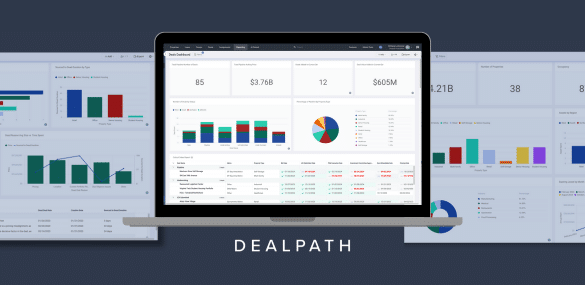To grow top-line revenue and deliver investor returns, investment management teams must review every deal relevant to their goals in a data-driven, and ideally, efficient manner. But with numerous deal screening, underwriting and due diligence processes to follow, it’s not uncommon for deals to lose momentum as teams juggle priorities. Building efficiencies to manage ongoing pipeline growth is paramount to outperforming competitors.
Through partnerships with leading real estate investment management firms like Oxford Properties, Blackstone and Nuveen, we’ve identified and implemented best practices that drive seamless scalability. On the one hand, hiring additional analysts puts more boots on the ground, theoretically creating bandwidth to manage additional deals. But with new hires comes an important caveat: training and onboarding new employees while the root issue persists.
How long does it take to create pipeline reports? How many people can edit a deal tracking spreadsheet at once? Is all pertinent deal information readily accessible to everyone who needs it? Identifying and solving operational inefficiencies is the best route to achieving scalable growth.
According to CBRE, US investment in commercial real estate increased by 45% in 2022–meaning that the market holds ample opportunity.While firms consider new ways to manage deal flow and actually execute deals, they’re simultaneously raising higher funds for ongoing portfolio growth. However, larger capital pools call for increased oversight into how deals are sourced, evaluated and executed.
Juggling these priorities is a delicate balancing act, but finding new ways to expedite and optimize deal flow is the key to accomplishing urgent execution work in tight time windows. Ultimately, this can only be achieved by strategically implementing the right deal management software platform.
Jump to:
- Data is Difficult to Record and Leverage With Confidence
- Lack of Real-Time Visibility Into Deals & Data
- Deal Communication Is Time-Consuming
- Data-Driven Deal Analyses & Reporting Are Resource-Intensive and Inconclusive
- Tracking Tasks & Communications For Every Deal
Achieve Scalable Growth by Solving These 5 Operational Inefficiencies
As firms gradually recognize these operational hurdles, some have already implemented new software to handle higher deal volumes. Others are only beginning to strategically use technology, cobbling together industry-agnostic tools that might address a few select issues. The right software will align with your firm’s existing processes and strategies, developing a stronger system of record without compromising data security.
Before achieving sustainable growth, your firm must consider how to eliminate operational inefficiencies that could stand in the way of closing highly profitable deals. Read on to learn about the most common bottlenecks that create operational inefficiencies in the deal pipeline, and how to solve them by implementing real estate investment software.
1. Data is Difficult to Record and Leverage With Confidence
The problem: Data is stored in siloed spreadsheets, without a universal point of access or scalable system of record
Each deal your firm reviews has several data points associated with it, from property-related data to purchase prices and more. Unfortunately, this data is often lost in siloed spreadsheets, or left in the dust as properties progress from deal teams to asset management.
When it comes time for deal teams to leverage these comps, they face the choice of using potentially outdated data, requesting updates from its new owner, or conducting independent research. In some circumstances–for example, if an analyst leaves the firm–that data might be lost altogether. One instance of this confusion might only cost a few hours, but regularly working to gather, regather and disseminate data is unscalable.
The Solution: Centralize data in a universally accessible deal management platform, which acts as the single source of truth
Centralizing this data in the cloud provides access across the board, without organizational structures creating limitations. By transitioning away from spreadsheets to a cloud-based deal management software platform, you can bypass these challenges. Some deal management platforms allow users to strategically automate data streams, taking the burden of data entry off their plates and reducing errors in the process.
As new deals flow in, or old deals receive updates, that information is reflected in real time. With accurate data at an arm’s reach, investors can decisively deploy capital with full confidence, greater efficiency, and before the competition.
2. Lack of Real-Time Visibility Into Deals & Data
The Problem: It takes time & extensive communication for investment managers to accurately evaluate their deal pipeline
Keeping a pulse on viable pipeline deals is crucial for senior management to allocate resources, project financials, and, generally, to gain oversight into their team’s day-to-day work. However, the spreadsheet operating model–in which analysts track deals in spreadsheets–can stifle the flow of information. After all, only one individual can make manual edits at a time as multiple deals evolve in real time.
Even following these updates, the true state of the pipeline may not be readily apparent. Senior management must dig deeper to see which deals present the best opportunities based on the location, property type, and more–which can be a time-consuming endeavor in a spreadsheet. Instead, executives often rely on others to fill in the blanks so that the data can be used in a meaningful way.
The Solution: Track deals in real time, with sortable filters for added clarity
Teams that leverage a deal management solution like Dealpath circumvent this obstacle by tracking every deal’s stage with real-time visibility. Senior management can even zoom in to look at their pipelines by market, deal type or another variable thanks to standardized data. Tracking deals in real time ensures that firm leaders are armed with the data required to make day-to-day decisions, confer with the Investment Committee and accomplish other goals.
3. Deal Communication Is Time-Consuming
The Problem: Investment processes rely on frequent meetings, email communication and other obligations to facilitate deal discussion
Traditional deal-tracking spreadsheets provide limited information. Because of this, teams that use these rely on supplemental forms of communication to remain up-to-date on deals. This communication often takes the form of ad-hoc email requests, in-person conversations, and largely, pipeline update meetings. When next steps are unclear, the core focus of these meetings could become filling information gaps, rather than moving forward on profitable opportunities to drive portfolio growth.
The Solution: Run your pipeline meetings based on data in a deal management platform
When utilizing a deal management platform that presents deal progress in a clear, visualized format, the need for long, data-heavy meetings often fades. For many tech-enabled teams that have overcome this operational inefficiency, pipeline meetings have become a curated conversation about deals in the pipeline, as viewed through pre-configured dashboards. Rather than clarifying information, deal teams can instead consider profitable opportunities under a closer lens, or scale their pipelines with more deals.
4. Data-Driven Deal Analyses & Reporting Are Resource-Intensive and Inconclusive
The Problem: Because data is siloed in spreadsheets, reporting, strategizing and uncovering market trends consume bandwidth
Storing deal data in spreadsheets provides little utility following the lifecycle of that investment, and a lack of standardization can further complicate this process. Even after tracking down up-to-date data, analysts must build models to analyze the deal at hand. Similarly, compiling reports can also be a laborious process that detracts from higher priorities, like deal execution. It should never take hours or days to screen a deal or deliver a report, but a lack of data hygiene can sometimes make this the reality. Due to the risk of outdated data, deal teams might ultimately be left without confidence in the final answer.
The Solution: Standardize data for turnkey insights throughout the investment process
Purpose-built deal management platforms like Dealpath are designed to standardize deal data, making that data easy to leverage without additional work from your team’s end. In addition to having streamlined access to centralized data, analysts can filter deal data based on the location, property type, and other designated variables to find answers, or generate specific reports. Most importantly, data-driven analysis and reporting can become a standard, turnkey step as part of a streamlined workflow. With this in mind, you can turn your data into your competitive advantage, with real-time insights waiting at your fingertips.
5. Tracking Tasks & Communications For Every Deal
The Problem: Teams struggle to collaborate due to decentralized tasks and communications
When different phases of the deal lifecycle are managed in different software, tracking many moving targets becomes a challenge in itself. It’s not uncommon for managers to assign tasks during meetings, via email, through a dedicated project management system, or even during water cooler conversations. Tracking input, approvals or changes given through disparate email threads makes for a disjointed system that’s prone to error. In the end, teams are left to reconcile changes provided through multiple systems and methods of communication to shape their task lists, often at the expense of other tasks that fall off their radars.
The Solution: Manage tasks and centralize deal communications in one platform
Deal management software empowers all teams–from the largest institutional investors to boutique firms–to manage the full deal lifecycle in one centralized platform. Standardized checklists ensure that no steps slip through the cracks, while also preventing analysts from recreating the checklist for each deal. Automated workflows push the right deals to their owners at the right times, taking the onus off of busy team members. From one place, anyone in the organization can view approaching critical dates and historical commentary, preserving critical details for the future.
Uncover the Most Profitable Opportunities With Clear, Real-Time Visibility
In an industry that’s increasingly dominated by tech-enabled investment firms, deal teams can only be as effective as their technology enables them to be productive. With a deal management platform fully implemented and driving your investment processes, your team can work more efficiently, but also uncover the most profitable opportunities.
To learn more about how industry leaders grow their portfolios by building operational efficiencies and scaling their pipelines in Dealpath, schedule a demo.
Schedule a Demo




